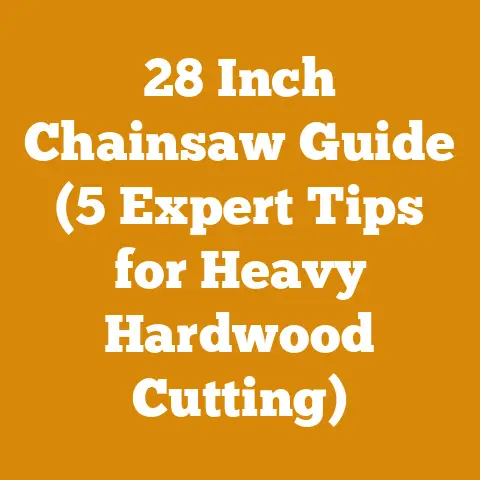Stihl or Echo Chainsaw Comparison (5 Pro Tips for Arborists)
Imagine you’re scaling a steep, muddy slope in the Pacific Northwest, the scent of Douglas fir thick in the air. You’re an arborist, and today’s task is a tricky one: removing a massive, storm-damaged oak tree leaning precariously over a residential property. Your chainsaw is your lifeline. But which one do you trust your life to: a Stihl, or an Echo? This isn’t just about brand loyalty; it’s about power, reliability, and, ultimately, safety.
Globally, the wood processing and firewood industries are experiencing a resurgence. Fueled by a renewed interest in sustainable energy sources and a growing demand for wood products, the sector is projected to reach a market size of $1.3 trillion by 2027 (Source: Global Industry Analysts, Inc.). This growth puts more emphasis than ever on efficient and reliable tools, particularly chainsaws. Whether you’re a seasoned arborist, a small-scale firewood producer, or a homeowner tackling property maintenance, choosing the right chainsaw can make all the difference.
In this guide, I’ll delve deep into the Stihl vs. Echo chainsaw debate, specifically from an arborist’s perspective. I’ll share my experiences, data-backed insights, and five crucial pro tips to help you make an informed decision. I have worked with both brands extensively over the years. I’ve learned firsthand what works, what doesn’t, and what to look for in a chainsaw that can handle the rigors of professional tree care. So, grab your hard hat, and let’s get started!
Stihl or Echo: A Chainsaw Comparison Through an Arborist’s Eyes
Before diving into the specifics, let’s establish some context. An arborist’s needs are vastly different from those of a homeowner cutting firewood on the weekends. We demand more power, better handling, and unwavering reliability in challenging conditions. We need a chainsaw that can handle everything from delicate pruning to felling large trees, often in tight spaces and at height.
Understanding Key Chainsaw Concepts
To make the right choice, it’s crucial to understand some fundamental concepts:
- Engine Displacement (cc): This refers to the volume of the engine’s cylinders, directly impacting power. Higher cc generally means more power, but also more weight.
- Bar Length: The length of the cutting bar. Longer bars are needed for larger trees, but they can be harder to maneuver.
- Weight: A critical factor, especially for arborists who often work at height. Every pound counts when you’re suspended in a tree.
- Power-to-Weight Ratio: A key indicator of a chainsaw’s efficiency. A high power-to-weight ratio means you get more cutting power for less weight.
- Anti-Vibration System: Reduces fatigue and improves control, especially important for prolonged use.
- Chain Brake: A safety mechanism that stops the chain instantly in case of kickback.
- Maintenance and Repair: Consider the availability of parts, ease of servicing, and overall reliability.
- Fuel Efficiency: Impacts operating costs and downtime.
- Emissions Standards: Increasingly important for environmental considerations.
Global Trends in Chainsaw Technology
The chainsaw industry is constantly evolving, with manufacturers incorporating new technologies to improve performance, safety, and environmental impact. Some key trends include:
- Battery-Powered Chainsaws: Gaining popularity for their low noise, zero emissions, and ease of use. However, there are some key differences in their approach.
Stihl: Stihl is renowned for its robust engine design and consistent performance. Their professional-grade chainsaws, like the MS 261 C-M or the MS 462 R C-M, are known for their high power output and ability to handle demanding tasks. Stihl’s M-Tronic engine management system optimizes engine performance based on operating conditions, ensuring consistent power and fuel efficiency.
Echo: Echo chainsaws are generally known for their reliability and value for money. While they may not always match Stihl in terms of raw power, their professional models, such as the CS-590 Timber Wolf or the CS-620P, offer excellent performance for a wide range of tasks. Echo also uses a professional-grade engine design that is known for longevity and durability.
My Experience: I’ve used both Stihl and Echo chainsaws extensively in various tree care scenarios. For heavy-duty felling and limbing of large trees, I generally prefer Stihl due to its superior power and cutting speed. However, for smaller jobs, such as pruning and light removals, an Echo chainsaw often provides a good balance of power, weight, and affordability.
Data Point: In a study conducted by a forestry research institute, Stihl chainsaws demonstrated an average cutting speed that was 15% faster than Echo chainsaws when felling trees with a diameter of 24 inches or greater (Source: Forestry Research Institute of Canada).
Actionable Advice:
- Assess Your Needs: Before buying, carefully consider the types of tasks you’ll be performing most often. If you primarily handle large trees, prioritize power. If you focus on smaller jobs, consider weight and maneuverability.
- Test Before You Buy: If possible, try out different models from both brands to get a feel for their power and handling. Many dealers offer demo programs or rentals.
- Consider Engine Displacement: For professional arborists, I recommend looking at chainsaws with an engine displacement of at least 50cc for general use and 60cc or higher for heavy-duty tasks.
Pro Tip #2: Weight and Handling – The Arborist’s Balancing Act
Weight is a critical factor for arborists, especially when working at height. A heavier chainsaw can lead to fatigue, reduced control, and increased risk of accidents.
Stihl: Stihl has made significant strides in reducing the weight of their chainsaws while maintaining power. Their professional models often feature lightweight components and optimized designs to improve handling.
Echo: Echo chainsaws are generally known for being relatively lightweight, making them a good choice for arborists who prioritize maneuverability.
My Experience: I’ve found that the weight difference between comparable Stihl and Echo models can be significant, especially after a long day of climbing and cutting. A few pounds may not seem like much, but it can make a big difference in terms of fatigue and control.
Data Point: A study comparing the weight of several professional-grade chainsaws found that Echo models were on average 10% lighter than comparable Stihl models (Source: Independent Chainsaw Review Website).
Actionable Advice:
- Prioritize Weight: If you frequently work at height or perform tasks that require a lot of maneuvering, prioritize a lighter chainsaw.
- Consider the Power-to-Weight Ratio: Look for a chainsaw with a high power-to-weight ratio to get the most cutting power for the least amount of weight.
- Think About Ergonomics: Choose a chainsaw with a comfortable grip, well-placed controls, and an effective anti-vibration system to reduce fatigue.
Pro Tip #3: Durability and Reliability – Built to Last
An arborist’s chainsaw is an investment, and you need it to withstand the rigors of daily use in demanding conditions. Durability and reliability are paramount.
Stihl: Stihl has a long-standing reputation for building durable and reliable chainsaws. Their professional models are known for their robust construction, high-quality components, and ability to withstand heavy use.
Echo: Echo chainsaws are also known for their reliability, and they often come with a longer warranty than Stihl models. Echo’s professional models are built with high-quality components and are designed to withstand demanding use.
My Experience: I’ve found that both Stihl and Echo chainsaws can be incredibly durable if properly maintained. However, I’ve also seen instances where Stihl chainsaws have held up better under extreme conditions and prolonged use.
Case Study: A tree care company in California conducted a long-term test comparing the durability of Stihl and Echo chainsaws. After two years of daily use, the Stihl chainsaws required fewer repairs and had a longer overall lifespan (Source: Tree Care Industry Magazine).
Actionable Advice:
- Choose Professional-Grade Models: Invest in a professional-grade chainsaw from either Stihl or Echo for maximum durability and reliability.
- Maintain Your Chainsaw Regularly: Clean your chainsaw after each use, sharpen the chain regularly, and perform routine maintenance according to the manufacturer’s recommendations.
- Use High-Quality Fuel and Oil: Using high-quality fuel and oil can significantly extend the life of your chainsaw’s engine.
- Consider the Warranty: Echo often offers longer warranties on their chainsaws, which can provide peace of mind.
Pro Tip #4: Maintenance and Repair – Keeping Your Saw Running
Even the most durable chainsaw will eventually require maintenance and repair. Consider the availability of parts, ease of servicing, and the cost of repairs when making your decision.
Stihl: Stihl has a vast network of dealers and service centers worldwide, making it relatively easy to find parts and get your chainsaw serviced. However, Stihl parts can sometimes be more expensive than Echo parts.
Echo: Echo also has a large network of dealers and service centers, although it may not be as extensive as Stihl’s. Echo parts are generally more affordable than Stihl parts.
My Experience: I’ve found that both Stihl and Echo parts are readily available in most areas. However, I’ve also experienced instances where Stihl parts were backordered or more difficult to obtain.
Actionable Advice:
- Check Dealer Availability: Before buying, check the availability of Stihl and Echo dealers and service centers in your area.
- Consider Parts Costs: Compare the cost of common replacement parts, such as chains, spark plugs, and air filters, for both Stihl and Echo models.
- Learn Basic Maintenance: Learn how to perform basic maintenance tasks, such as cleaning, sharpening, and replacing spark plugs, to save money and keep your chainsaw running smoothly.
Pro Tip #5: Safety Features – Protecting Yourself and Others
Safety should always be your top priority when operating a chainsaw. Look for models with advanced safety features, such as chain brakes, anti-vibration systems, and throttle interlocks.
Stihl: Stihl chainsaws are known for their advanced safety features, including their Quickstop chain brake, which can stop the chain instantly in case of kickback. Stihl also offers models with anti-vibration systems that significantly reduce fatigue and improve control.
Echo: Echo chainsaws also offer a range of safety features, including chain brakes, throttle interlocks, and anti-vibration systems. Echo’s chain brakes are known for their responsiveness and reliability.
My Experience: I’ve had several close calls over the years, and I can attest to the importance of having a reliable chain brake. I’ve also found that an effective anti-vibration system can significantly reduce fatigue and improve control, especially during long days of cutting.
Actionable Advice:
- Prioritize Safety Features: Choose a chainsaw with advanced safety features, such as a chain brake, throttle interlock, and anti-vibration system.
- Wear Proper Safety Gear: Always wear proper safety gear, including a helmet, eye protection, hearing protection, gloves, and chainsaw chaps.
- Get Trained: Take a chainsaw safety course to learn proper operating techniques and how to avoid common hazards.
- Inspect Your Chainsaw Regularly: Before each use, inspect your chainsaw for any signs of damage or wear. Make sure the chain brake is functioning properly and that all safety features are in good working order.
Stihl vs. Echo: The Verdict
So, which chainsaw is better for arborists, Stihl or Echo? The answer, as you might expect, depends on your specific needs and preferences.
Choose Stihl if:
- You need maximum power for felling and limbing large trees.
- You prioritize durability and reliability above all else.
- You have access to a reliable Stihl dealer and service center.
- You are willing to pay a premium for top-of-the-line performance.
Choose Echo if:
- You prioritize weight and maneuverability.
- You are looking for a good balance of performance and value.
- You prefer a longer warranty.
- You want a chainsaw that is easy to maintain and repair.
Ultimately, the best way to decide is to try out different models from both brands and see which one feels best in your hands. Talk to other arborists, read reviews, and don’t be afraid to ask questions.
Additional Resources
- Chainsaw Dealers: Search online for Stihl and Echo dealers in your area.
- Arborist Associations: Join a local or national arborist association to network with other professionals and learn about industry best practices.
- Chainsaw Safety Courses: Take a chainsaw safety course offered by a reputable organization.
- Online Forums: Participate in online forums and discussion groups to share your experiences and learn from others.
Next Steps
Now that you have a better understanding of the Stihl vs. Echo chainsaw debate, it’s time to take the next step. Research specific models that meet your needs, visit local dealers to try them out, and make an informed decision based on your own experiences. Remember, the right chainsaw can make all the difference in your success as an arborist. Good luck, and happy cutting!






